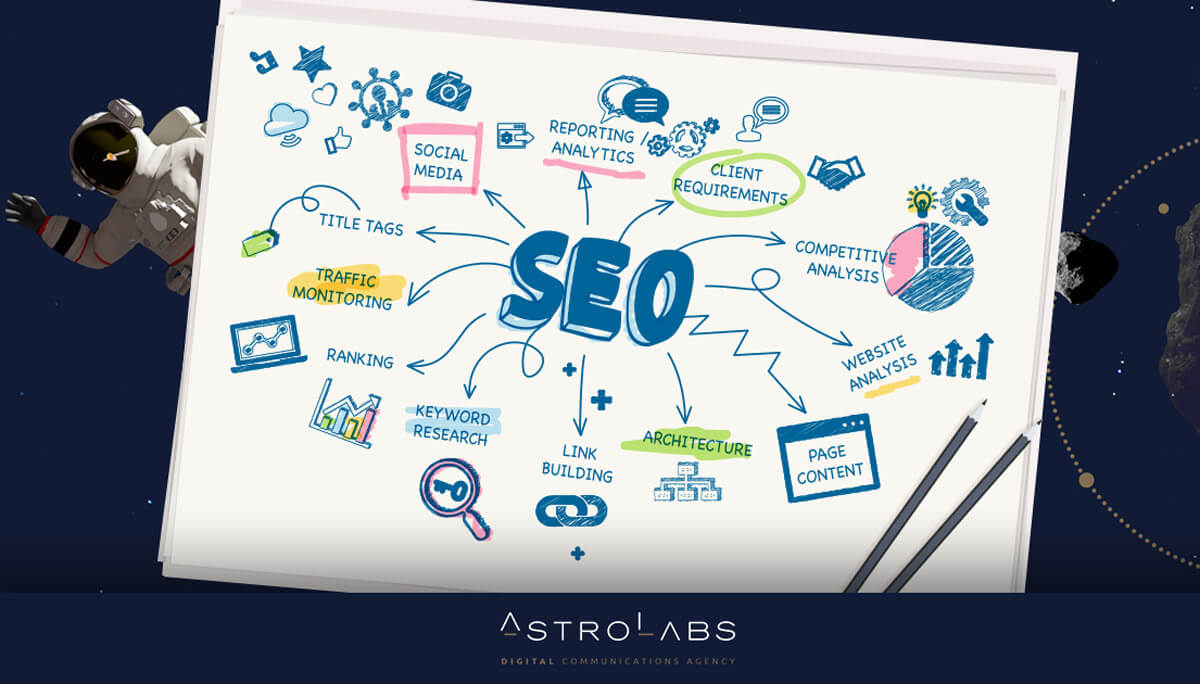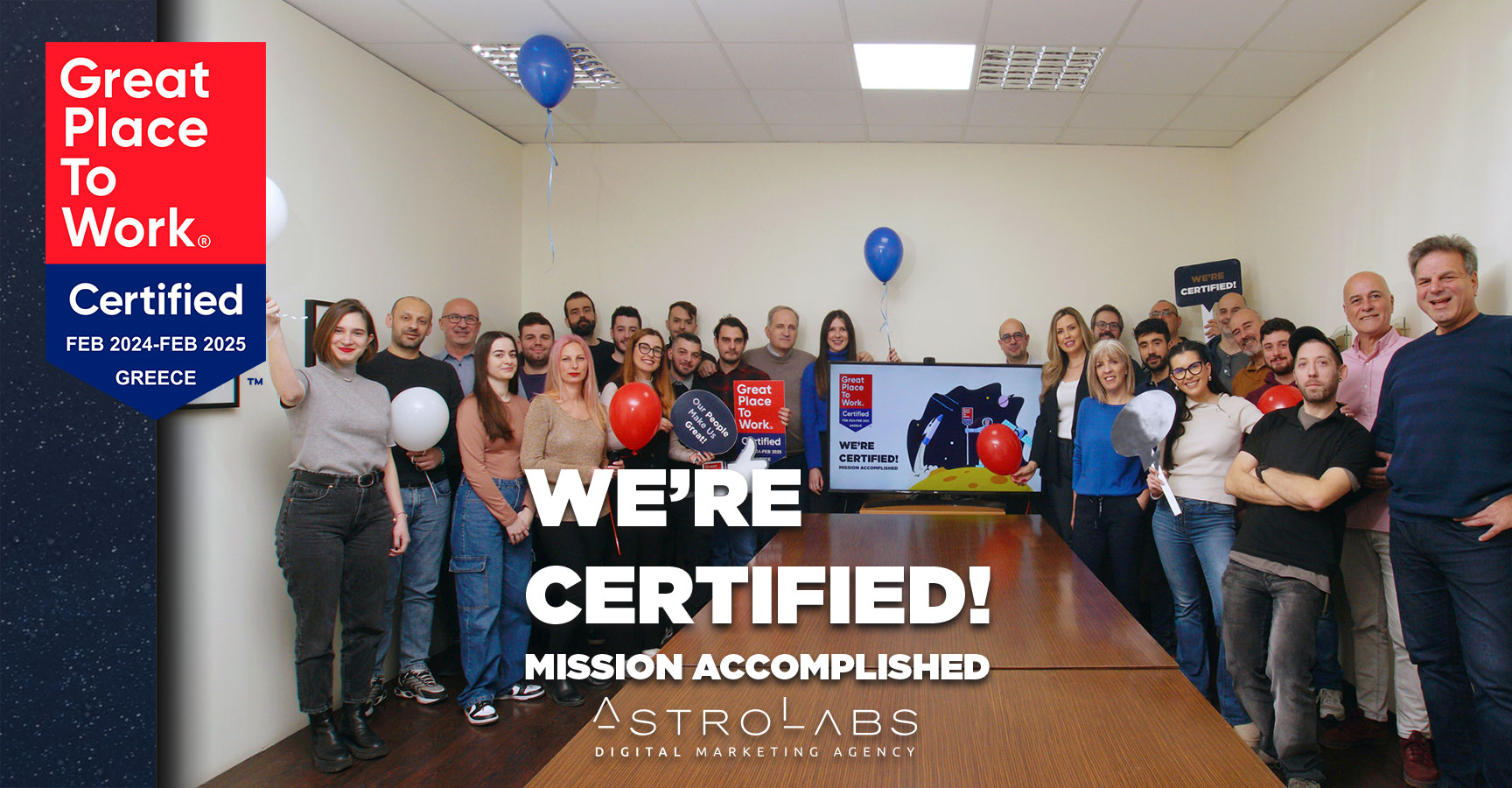We all want to see our own page appear at the top of Google searches. But how can we achieve this?
According to Google’s statistics, there are more than 2.2 million searches every day, so the competition is strong and uses all the digital tools at its disposal, especially when it comes to SEO.
Search engine optimization (SEO) is the process of optimizing a website by applying specific techniques in order to achieve a better organic ranking on search engine results pages and respectively increase its traffic.
AstroLabs SEO experts have developed a specific methodology to achieve results and share with you some simple SEO steps that you can do yourself!
1. Create Blogs and articles that appeal to your audience
Creating content that directly addresses the needs of your audience will help with your SEO. Think about how your blogs are essentially answering the questions that your customers will be googling. That is, as long as it relates to your products or services, your potential customers will land on your page before they even need to complete a purchase or transaction.
2. Add value to your page content
The more links leading to your page, the better your search engine ranking. But in order for users, other pages, blogs etc to want to share a link that leads to your page, it must be objectively worthy as content. The more niche (niche market) the more competitive!
3. Sharing is caring!
When do we click “share” on other pages’ social media? What are the factors that lead to this decision? This is what you need to keep in mind when creating your page’s social media content, think first as a user and then as a business. What material would you want to see yourself that you would consider worth sharing with your friends.
4. Use sources and links
Feel free to use links from other sources within your own original content where appropriate. Including links within the body of the page (not in the footer or sidebar) makes your website look more authoritative and boosts your SEO score!
5. Keywords, keywords, keywords!
By using free tools such as Google’s Keyword Planner, you can discover the right keywords related to your business and in the appropriate order of relevance. Find keywords and phrases related to your content and include them in the first and last paragraph of your page. Identify secondary keywords and phrases and place them in the middle paragraphs of your content. This can make a huge difference when search engine results rank your content for SEO.
6. Don’t underestimate your titles!
Your page titles and descriptions should be as attractive as possible, but without falling into the trap of becoming clickbait, which will damage your relationship with your audience. A headline should be honest, descriptive and evoke the interest of the audience. It is also very important to contain the keywords you want them to find you with. By paying a little more attention to titles, you give your audience more reasons to click on what they see!
7. Alt Tags “save” SEO
We know it may seem like unnecessary work but the alt tags of the images on your page are important to keep up to date. By simply uploading media you are not helping Google Search Engine to properly archive your page. But by filling in information within alt tags, you are giving more “light” to the search engines and your SEO score.
9. Spend a little extra time on your URLs
Don’t leave your URLs to chance. Most CMS tools (WordPress, Joomla, etc.) give you the option to modify your URLs to become regular words (with some restrictions). As well, in the case of pages in Greek, prefer your URLs to be in greeklish rather than in Greek characters.
10. The Value of a Memorable Domain
Your domain is your headquarters and you always want people to be able to find it easily and not accidentally go to a competitor. Try to find a domain that is not only relevant to your company but will ensure that people searching for your company will find you. This tactic also helps with Google’s “exact match” searches where it is one of the key SEO factors for your page.
11. XML Sitemaps should not lead to hidden treasures
Use tools like XML Sitemap Creator to create an XML sitemap from your HTML sitemap of your page. It sounds complicated for someone who has no previous experience with the subject but it’s a necessary process for your page’s SEO. Once the XML Sitemap is ready you can submit it to Google!
12. Headings are your main SEO weapon!
Headers (Headers , abbreviated H) are a key SEO factor on any website page because they are used to allow search engines to understand the information and content of your page.
Search engines “read” the content of the Title as it is more important to them than the rest. The Titles of a page therefore have a simple classification into H1 , H2 and H3 , which are the most important, and go up to H6.
But you cannot put any content you want in the Titles. It is important to use keywords (both short tail and long tail) as search engines when they “read” your website will identify them, recognize them and give your content a better ranking based on relevance. In simple words, you will appear higher in the organic results.
As a general principle, the H1 Title should contain the most targeted keywords that define the subject of the company / business. Title H2 should contain similar keywords to Title H1 but more specific. Finally, Title H3 has the use of a sub-Title and therefore should function explanatory and auxiliary to Titles H1 and H2.
Ideally you may think that Titles have a Hierarchy structure and therefore the smaller the number following a title, the more important it is for the SEO of your page.
SEO is a marathon, not a sprint. By following these basic rules, you will see very positive long-term results in your page’s SEO ranking. But the secret ingredient is consistency and constant engagement. The SEO experts at AstroLabs can offer you a free SEO analysis and evaluation of your website.



